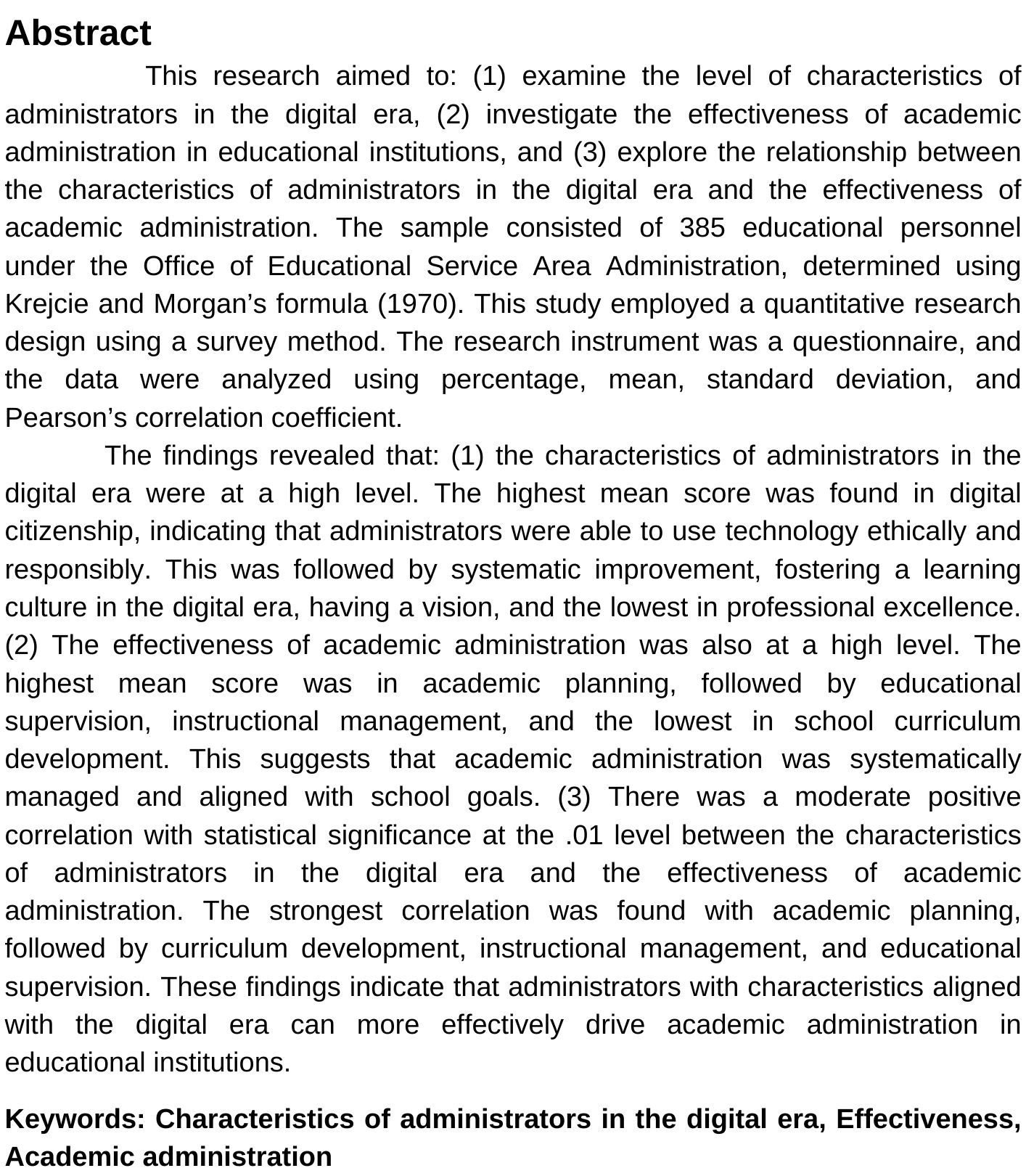Characteristics of Administrators in the Digital Era and Academic Administration Effectiveness of Educational Personnel, Office of Educational Service Area Administration
Keywords:
Characteristics of administrators in the digital era, Effectiveness, Academic administrationAbstract
This research aimed to: (1) examine the level of characteristics of administrators in the digital era, (2) investigate the effectiveness of academic administration in educational institutions, and (3) explore the relationship between the characteristics of administrators in the digital era and the effectiveness of academic administration. The sample consisted of 385 educational personnel under the Office of Educational Service Area Administration, determined using Krejcie and Morgan’s formula (1970). This study employed a quantitative research design using a survey method. The research instrument was a questionnaire, and the data were analyzed using percentage, mean, standard deviation, and Pearson’s correlation coefficient.
The findings revealed that: (1) the characteristics of administrators in the digital era were at a high level. The highest mean score was found in digital citizenship, indicating that administrators were able to use technology ethically and responsibly. This was followed by systematic improvement, fostering a learning culture in the digital era, having a vision, and the lowest in professional excellence. (2) The effectiveness of academic administration was also at a high level. The highest mean score was in academic planning, followed by educational supervision, instructional management, and the lowest in school curriculum development. This suggests that academic administration was systematically managed and aligned with school goals. (3) There was a moderate positive correlation with statistical significance at the .01 level between the characteristics of administrators in the digital era and the effectiveness of academic administration. The strongest correlation was found with academic planning, followed by curriculum development, instructional management, and educational supervision. These findings indicate that administrators with characteristics aligned with the digital era can more effectively drive academic administration in educational institutions.
References
ฐานะ บุญรอด และวสันต์ชัย กากแก้ว. (2565). ภาวะผู้นำยุคดิจิทัลของผู้บริหารสถานศึกษา สังกัดสำนักงานเขตพื้นที่การศึกษามัธยมศึกษาสุรินทร์. วารสาร มจร อุบลปริทรรศน์, 7(3), 1137-1150.
ธิษตยา ภิระบัน. (2561). ความสัมพันธ์ระหว่างการบริหารงานวิชาการกับประสิทธิผลของสถาน ศึกษาขั้นพื้นฐาน สังกัดสำนักงานเขตพื้นที่การศึกษาประถมศึกษาเชียงราย เขต 1. วิทยานิพนธ์การศึกษามหาบัณฑิต สาขาวิชาการบริหารการศึกษา : มหาวิทยาลัยพะเยา.
ในตะวัน กำหอม. (2559). การวิจัยทางการศึกษา เล่ม 1. วิทยาลัยทองสุข : กรุงเทพฯ. โรงพิมพ์ทีคอม จังหวัดมหาสารคาม.
ประยงค์ ศรีโทมี. (2561). ปัจจัยทางการบริหารที่ส่งผลต่อประสิทธิผลการจัดการศึกษาของโรงเรียนในสังกัดสำนักงานเขตพื้นที่การศึกษามัธยมศึกษา เขต 20. วิทยานิพนธ์ปริญญาครุศาสตรมหาบัณฑิต : มหาวิทยาลัยราชภัฏสกลนคร.
ปรียาพร วงศ์อนุตรโรจน์. (2556). การนิเทศการสอน. กรุงเทพฯ : พิมพ์ดี.
วิมาลย์ ลีทอง. (2563). ปัจจัยการบริหารที่ส่งผลต่อประสิทธิผลโรงเรียน สังกัดสำนักงานคณะกรรมการการศึกษาขั้นพื้นฐานใน จังหวัดสกลนคร. วิทยานิพนธ์ปริญญาครุศาสตรมหาบัณฑิต สาขาการบริหารการศึกษา : มหาวิทยาลัยราชภัฏสกลนคร.
สาคร มหาหิงค์, บุญจักรวาล รอดบำเรอ และวิราภรณ์ ส่งแสง. (2565). คุณลักษณะผู้บริหารสถานศึกษายุคดิจิทัล. วารสารครุศาสตร์ปัญญา, 1(4), 62-75.
สุกัญญา แช่มช้อย. (2560). การบริหารสถานศึกษาในยุคดิจิทัล. กรุงเทพฯ : สำนักพิมพ์แห่งจุฬาลงกรณ์มหาวิทยาลัย.
หาญชัย เกียรติเฟื่องฟู, วิทยา จันทร์ศิลา และสถิรพร เชาวน์ชัย. (2565). ความต้องการพัฒนาคุณลักษณะในยุคดิจิทัลของผู้บริหารสถานศึกษาสังกัดสำนักงานเขตพื้นที่ การศึกษาประถมศึกษาแม่ฮ่องสอนเขต 2. หลักสูตรการศึกษามหาบัณฑิต สาขาวิชาการบริหารการศึกษา : มหาวิทยาลัยนเรศวร.
เอกชัย กี่สุขพันธ์. (2559). การบริหารโรงเรียนยุคดิจิทัล. [ออนไลน์]. แหล่งที่มา : https://www.trueplookpanya.com/education/content/52232 [15 มกราคม 2568].

Downloads
Published
How to Cite
Issue
Section
License
Copyright (c) 2025 Institute of Sufficiency Journal

This work is licensed under a Creative Commons Attribution-NonCommercial-NoDerivatives 4.0 International License.


